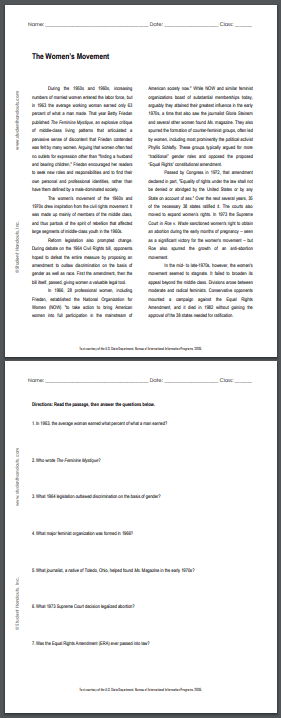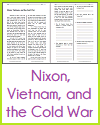The Women's Movement |
 During the 1950s and 1960s, increasing numbers of married
women entered the labor force, but in 1963 the average working
woman earned only 63 percent of what a man made. That year Betty
Friedan published The Feminine Mystique, an explosive critique
of middle-class living patterns that articulated a pervasive
sense of discontent that Friedan contended was felt by many
women. Arguing that women often had no outlets for expression
other than "finding a husband and bearing children," Friedan
encouraged her readers to seek new roles and responsibilities
and to find their own personal and professional identities,
rather than have them defined by a male-dominated society. During the 1950s and 1960s, increasing numbers of married
women entered the labor force, but in 1963 the average working
woman earned only 63 percent of what a man made. That year Betty
Friedan published The Feminine Mystique, an explosive critique
of middle-class living patterns that articulated a pervasive
sense of discontent that Friedan contended was felt by many
women. Arguing that women often had no outlets for expression
other than "finding a husband and bearing children," Friedan
encouraged her readers to seek new roles and responsibilities
and to find their own personal and professional identities,
rather than have them defined by a male-dominated society.The women's movement of the 1960s and 1970s drew inspiration from the civil rights movement. It was made up mainly of members of the middle class, and thus partook of the spirit of rebellion that affected large segments of middle-class youth in the 1960s. Reform legislation also prompted change. During debate on the 1964 Civil Rights bill, opponents hoped to defeat the entire measure by proposing an amendment to outlaw discrimination on the basis of gender as well as race. First the amendment, then the bill itself, passed, giving women a valuable legal tool. In 1966, 28 professional women, including Friedan, established the National Organization for Women (NOW) "to take action to bring American women into full participation in the mainstream of American society now." While NOW and similar feminist organizations boast of substantial memberships today, arguably they attained their greatest influence in the early 1970s, a time that also saw the journalist Gloria Steinem and several other women found Ms. magazine. They also spurred the formation of counter-feminist groups, often led by women, including most prominently the political activist Phyllis Schlafly. These groups typically argued for more "traditional" gender roles and opposed the proposed "Equal Rights" constitutional amendment. Passed by Congress in 1972, that amendment declared in part, "Equality of rights under the law shall not be denied or abridged by the United States or by any State on account of sex." Over the next several years, 35 of the necessary 38 states ratified it. The courts also moved to expand women's rights. In 1973 the Supreme Court in Roe v. Wade sanctioned women's right to obtain an abortion during the early months of pregnancy – seen as a significant victory for the women's movement – but Roe also spurred the growth of an anti-abortion movement. In the mid- to late-1970s, however, the women's movement seemed to stagnate. It failed to broaden its appeal beyond the middle class. Divisions arose between moderate and radical feminists. Conservative opponents mounted a campaign against the Equal Rights Amendment, and it died in 1982 without gaining the approval of the 38 states needed for ratification. |
Directions: Read the text above, then answer the
questions below. 1. In 1963, the average woman earned what percent of what a man earned? 2. Who wrote The Feminine Mystique? 3. What 1964 legislation outlawed discrimination on the basis of gender? 4. What major feminist organization was formed in 1966? 5. What journalist, a native of Toledo, Ohio, helped found Ms. Magazine in the early 1970s? 6. What 1973 Supreme Court decision legalized abortion? 7. Was the Equal Rights Amendment (ERA) ever passed into law? Click here to print. |
 |
|---|
Text courtesy of the U.S. State Department, Bureau of International Information Programs, 2005 |











